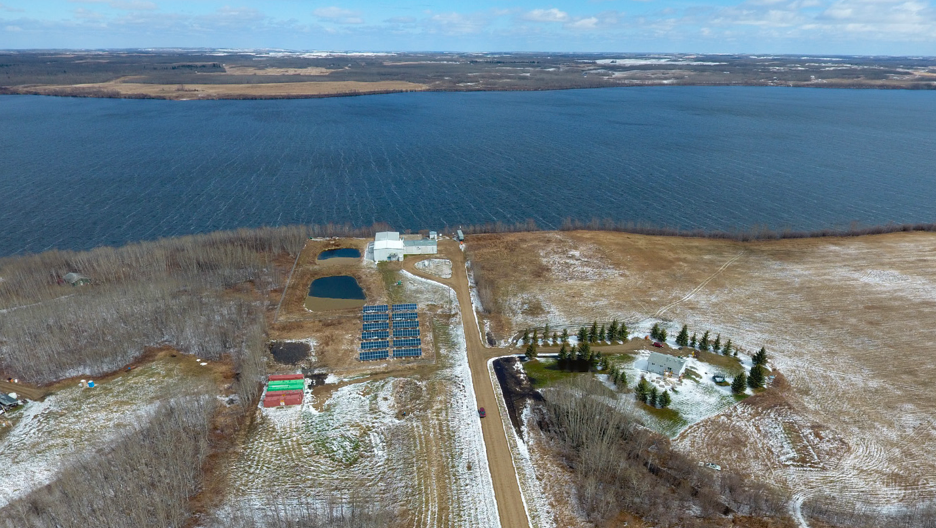Beginning in October of 2018, two members of the Gift Lake Métis Settlement began training as Environmental Monitors through a partnership between the Indigenous Community-Based Climate Monitoring Program and the Gift Lake Métis Settlement. Gift Lake is a small Métis community located roughly 400 km northwest of Edmonton, Alberta and sits in the heart of the boreal forest. It is surrounded by rich vegetation, forests and many water bodies left behind by ancient glacial meltdown. Once the Gift Lake Environmental Guardianship Program began, we focused on the primary concerns of the people within the community. This started with one-on-one interaction with elders through interviews and surveys filled with questions relating to the similarities and changes in the environment and climate of Gift Lake over the years. Through this communication it was clear what our goals would be: educating ourselves and the community, while maintaining a balance between a scientific approach to research and a sense of community through human interaction and methodology.
An elder in the community said, “nothing connects us more to our culture than the land.” She was right. Indigenous people have had a very close tie to the environment for millennia. Now we can tie culture, science and education to protect our culture through the protection of our invaluable environment. We immediately enrolled in Environmental Education programs and soon we were out in the field daily. Our efforts were split into 6 categories: air, weather, water, vegetation, traditional plants and wildlife while making sure to continually have an active presence and relationship with the community. Weather monitoring stations were installed on the north and south ends of the community and the data is collected daily in the effort to fill a data gap that has existed in the area until now. A water monitoring project was initiated through field level testing. Our main goal for the water monitoring efforts is to note any major or alarming trends that could affect quality of the water which would affect the quality of life for all living things. From our tests, three initiatives were born: bridge building for ATV stream crossings, ongoing lake sweeps for abandoned nets and waste, and the continual monitoring of the water levels in our three largest lakes.
On top of taking a scientific initiative to learn about the land and climate, we also wanted to bring awareness to the community. We have taken the opportunity to be part of land-based learning activities at the K-9 school through facilitating workshops on topics including dendrochronology, climate change, drone flying, rabbit snaring, traditional herbs and even gun safety. A High School in High Prairie, Alberta also invited us to speak to students and introduce the prospect of being employed in the environmental field. We would speak on issues regarding climate change and relate on a more personal level including our successes, struggles and overall experiences growing up in a small Indigenous community and moving into adulthood. In the spring of 2019 two high school students were hired as trainees and included in all our environmental, climate action and community engagement activities. We did this not only to teach, but to instill the importance of the environment by introducing them to the beauty of their surroundings and the amount of gratification and confidence that comes from protecting our lifeline. The youth have taken part in dendrochronology (tree aging), bridge building, water testing, weather monitoring, wildlife monitoring, well-site reclamation, tree planting, marking traditional herb GPS waypoints, facilitating a large cultural camp with 7 other communities and numerous community engagement events. They have also been given the opportunity to take part in community-based projects such as designing and building the community two new welcome signs, starting a community garden, building a children’s park and initiating a garbage clean-up with elementary school children; allowing them to play a mentorship role as well. Since returning to school both youths have contacted us expressing how much they loved the program and how they hope to come back next summer. This is the level of interest and environmental responsibility we wish to instill within the entire community.
The struggle to succeed does weigh heavy on us at times and we understand the differences in everyone’s views about climate change and environmental protection. We have seen failures, but they are over-shadowed by successes. Our environmental and climate change programs are only in their beginning stages and programs like this are extremely new to everyone around us. We welcome the challenge and treat our roles as a major responsibility to act as champions for the land. We believe there is only one possible way to achieve that: to be role models among the people.

Installation of north end weather monitor

Building ATV crossing on a fish bearing stream

Community garbage clean-up

Climate change workshop during Gift Lake Culture Camp

Gift Lake Culture Camp

Youth trainees on left after completing the construction of a small playground

Youth trainees after finding a 1950 Buick Riviera while marking waypoints on historical trails

Mentorship during reclamation project on abandoned well-site

Youth use an increment borer to find the age of a tree

Youth expresses his love for a 150-year-old tree

Youth pulls abandoned gill net from Utikumasis Lake during lake sweep

Pre-school session on the importance of moose. Included making birch bark callers

Grade 3 and 4 nature walk. Session on the role of rabbits in the environment and traditional snaring activity

Grade 3 and 4 nature walk with information session

High School presentation and information session

One of two signs designed and installed by Gift Lake Youth

New community garden
Author: Gift Lake Métis Settlement





















